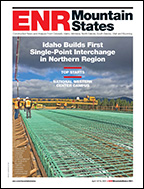

Prefabricated steel arches, liquid nitrogen-cooled concrete and two perched box caisson river piers are facilitating the construction of a new $307.5-million Sellwood Bridge in Portland, Ore.—the largest project of its kind in the history of Multnomah County.
In 2013, crews with the Sundt-Slayden joint venture contractor moved a 1,100-ft-long truss span 66 ft north to serve as a temporary detour over the Willamette River. Since then, other techniques have kept the team busy. Crews are currently erecting self-weathering steel spans that were trial-assembled at a fabricator in Vancouver, Wash., to meet tight tolerances. "The fit above the arches in conjunction with the concrete construction made getting the built conditions exactly right pretty critical," says Chad Yount, the team's project manager.
Arch construction started in mid- December and will last until late May, giving crews until fall 2015 to construct and open the main deck. For the in-water pier concrete pour of 3,000 cu yd of 6,000-psi concrete that forms the foundations of two piers, crews used a combination of liquid nitrogen in the concrete and a cooling system that ran hundreds of tubes through the pier with constant river flow to keep the temperature down.
"The combination of the two different things," Yount says, "is not typical."
Geological conditions on the west side have proven troublesome. Crews had to build a complex web of shear piles and tie-backs before the detour bridge was moved. They also monitored the weight of construction materials to make sure the project did not aggravate landslide conditions, says Mike Pullen, Multnomah County spokesman.
To navigate the tight in-water rules due to migratory fish species, the team built perched box caissons above water that were then lowered into the water so that the pier caps could be built in a dry box. In-water work will take center stage next year, when Yount says the team will use wire sawing and a pulley system to remove the old piers instead of building a cofferdam, dewatering and excavating traditionally. "The money, time and environmental impacts are a lot less," he says.
All this is being done with no more than 30 days of total bridge closure before the project wraps up in fall 2016. The site's tight footprint includes Portland's West Hills and landslide infrastructure on one side and residences on the other.
Pullen says that the county has learned valuable lessons in the construction manager-general contractor method of project delivery, which it will employ in the upcoming Broadway Bridge Rall Wheel Replacement Project. This was also the first county project to use an owner's representative—David Evans and Associates of Portland.






